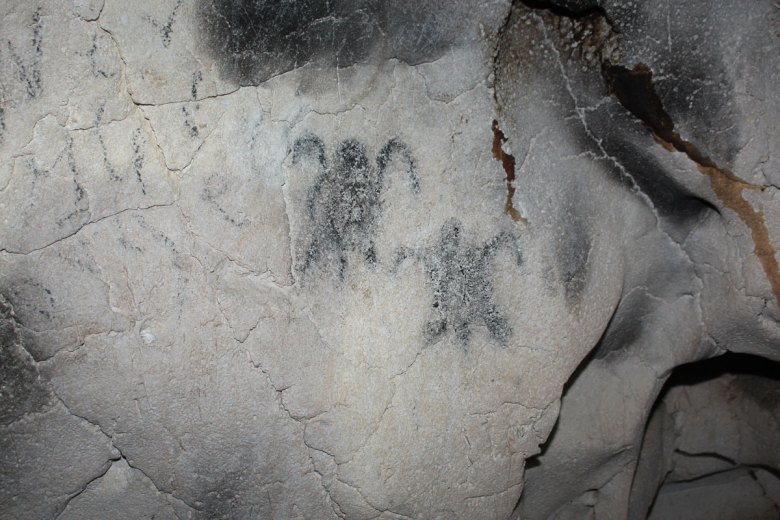“Such advances will help untap the huge cultural reservoir of knowledge preserved in the spectacular cavescapes across the Caribbean.”
Art depicting human figures, animals, and even boats adorns the caves of Puerto Rico. Now, new research has indicated that some of these drawings were made as long ago as 700 BCE—thousands of years before the arrival of European colonists to the Puerto Rican archipelago.
“This is the first direct [age] from paints that we have from Puerto Rico’s main island,” said Angel Acosta-Colon, a geophysicist at the University of Puerto Rico at Arecibo and a coleader of the research.
Cave art in Puerto Rico takes three forms: petroglyphs carved into rock, pyroglyphics drawn from the burnt remains of objects, and pictographs drawn with pigments. Acosta-Colon and Reniel Rodríguez Ramos, an archaeologist at the University of Puerto Rico at Utuado, sampled 61 organic pigments from pictographs in 11 different caves.
With permission from the Puerto Rican Cultural Institute, the researchers sampled commonly seen images, sparing art that was unique to preserve it for future generations.
The pigments consisted primarily of guano or charcoal, likely deposited or created around the same time that the paintings were made, Acosta-Colon said. Still, he acknowledged that the precise ages of the pigment and the timing of the drawings could be different.
“This is the first direct [age] from paints that we have from Puerto Rico’s main island.”
Carbon-14 dates from the pigments showed that the earliest pictographs—depicting abstract shapes—were created between 700 and 400 BCE.
“This groundbreaking scientific research by Rodriguez Ramos and Acosta-Colon highlights how we can begin to resolve the temporal complexity of Puerto Rican rock art,” said Jago Cooper, an archaeologist at the University of East Anglia and head curator of the Americas for the British Museum. Cooper was not involved in the new research. “Such advances will help untap the huge cultural reservoir of knowledge preserved in the spectacular cavescapes across the Caribbean,” he said.
A History of Drawings
Artistic styles in Puerto Rico’s caves evolved through time: Other cave drawings that depicted human figures had carbon-14 dates between 200 and 400 CE, and progressively more detailed drawings of animals and people, including images of ships and horses, were created from between 700 CE and the beginning of European colonization around 1500 CE. From about 1100 to 1300 CE, there was a “boom of cave art in Puerto Rico,” Acosta-Colon said.

The paintings align with the timeline of European colonization, too: Pigment sampled from a drawing that Acosta-Colon believes depicts a lion was dated to around 1500 CE, coinciding with the arrival of Europeans and enslaved Africans to Puerto Rico. Lions have never lived in Puerto Rico, indicating that the drawing may be the first example of slave-drawn cave art in Puerto Rico, Acosta-Colon said. The researchers presented their results in October at the Geological Society of America meeting in Pittsburgh.
Caves on other islands in the Puerto Rican archipelago also contain art. Researchers estimate that paintings in caves on Mona Island, about 140 kilometers (85 miles) off the coast of Puerto Rico’s main island, were created between about 1000 and 1600 CE.
Rewriting Indigenous History
The researchers’ findings shed light on the precolonial and postcolonial history of Puerto Rico, adding to previous evidence that Indigenous Puerto Ricans lived on the island as early as 6,000 years ago.
“This proves that we were here [thousands] of years before the European invasion,” Acosta-Colon said in a statement. Because the team sampled only 11 of the more than 300 caves and shelters on Puerto Rico’s main island, further research will likely reveal even older cave art, he said.
Often, the public’s understanding of Indigenous Peoples and history is biased by Eurocentric colonial worldviews and not based on data, Paulette Steeves, an archaeologist at Algoma University in Ontario, Canada, wrote in an email. Steeves was not involved in the new research.
Research such as this provides a counterdiscourse to Eurocentric views that may overlook the length of time Indigenous People lived in a region, which can be central to reclaiming and honoring the true history of Indigenous Peoples, Steeves wrote.
—Grace van Deelen (@GVD__), Staff Writer